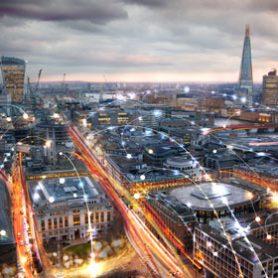Lighting the future: The Capital has long been a testbed for innovative new ways of lighting urban walkways and roads. On a trip to London in the mid-eighteenth century German author Karl Philipp Moritz wrote that the city’s oil street lamps created an awe-inspiring ‘festival of illumination’. In 1807 the world’s first gas-fired public street lamps were installed along Pall Mall by inventor Friedrich Winzer. 20 years later more than 40,000 lights were burning bright along 200 miles of London streets.
Built in the 1880s, Electric Avenue in Brixton became the first street in the world to bask in the glow of modern electric street lighting. This followed 80 years after Sir Humphrey Davy demonstrated the world’s first incandescent lightbulb in London in the early nineteenth century. Electric street lights were cheaper to run than earlier gas versions and proved to be a more effective way of illuminating the routes Londoners used for work and leisure. Today London is still lit up by 1,500 gas street lamps, each hand-lit by a team of five engineers.
The introduction of reliable electric street lighting made urban spaces more user-friendly, mitigating the threat of crime and making night-time commerce a more viable proposition. A University of Southampton study of the impact on citizens’ fear of crime of public investment in street lamps revealed that lighting inspires an enhanced sense of safety and community belonging. Street lighting inspires confidence in communities, with citizens comfortable to move around in brightly illuminated urban spaces.
The last few decades have seen rapid technological innovation touch virtually every aspect of our lives. But street lighting has not kept up. Some 75 percent of Europe’s street lights are more than 25 years old. Conventional street lighting is hugely expensive, costing European taxpayers around €3 billion each year to maintain. Street lighting accounts for up to half of European cities’ energy bills.
Now EU smart cities programme Sharing Cities is embracing an innovative new generation of smart lampposts in a bid to improve quality of life for people who live and work in cities. Sharing Cities is pioneering new smart lampposts that are harnessing the power of data to address pressing city challenges such as chronic air pollution.
Headquartered in London, Sharing Cities is currently overseeing the testing of smart lampposts in Lisbon with a view to further roll-out in the UK and beyond. As well as performing all the functions expected of conventional street lighting, the lampposts are equipped with sensors that collect data on key metrics such as air quality and noise pollution. The data is then fed into an urban sharing platform where it can be analysed in a bid to gain an insight into the intricate details of a city’s air and noise pollution problem. This data can be used by city authorities to warn citizens of pollution blackspots. In the long term, smart lampposts will both help cities formulate better-targeted air quality policy and address the challenge posed by chronic noise pollution.
As well as creating opportunities to gather insightful data, smart lampposts will deliver sizable savings for cities used to bearing the huge costs of maintaining conventional street lighting. If all European cities replaced their existing street lighting with smart lampposts, city authorities could save an estimated €2.1 billion annually.
Smart street lighting doesn’t just enable city authorities to better monitor key environmental metrics and drive down costs. Helping to ease the transition away from heavily-polluting petrol and diesel cars, smart lampposts also double-up as charging points for electric vehicles. With more than 2 million electric cars on the road across the world, smart lampposts are helping to make possible a new generation of vehicles that are more efficient and less polluting.
People who live and work in cities that upgrade their street lighting infrastructure also stand to benefit from the enhanced connectivity that smart lampposts provide. Smart lampposts are already delivering free Wi-Fi in urban areas. With mobile data traffic set to grow nine-fold between 2015 and 2020 and telecoms infrastructure in dense urban areas struggling to meet the growing demand, smart lampposts are crucial if cities are to maintain high-speed internet access for all citizens in the future, which Lighting the future.
In tandem with smart street lighting, Sharing Cities is pioneering a raft of new ways of using data to make urban areas more user-friendly. In London the programme is set to introduce smart energy systems into hundreds of offices and homes. Smart energy meters will be used to collect data to create a detailed picture of how consumers are using power in the context of an increasingly round-the-clock economy. Insights from this data can be used to better map out capacity demands and avert the threat of blackouts.
Cities have embraced the power of light to make the urban environment one where economies can grow and individuals can thrive. Now cities must harness the transformative potential of data to forge a better future for today’s city-dweller.
About the author
Nathan Pierce is current Chair of the Board of Coordinators of the 12 Lighthouse Projects. He is Programme Director of Sharing Cities – one of 12 Horizon 2020 Smart Cities and Communities and Lighthouse Projects.



